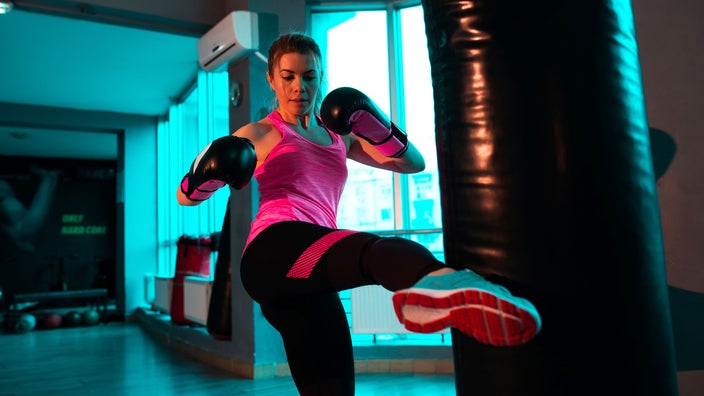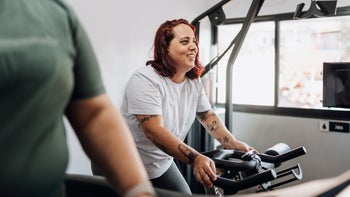
7 Benefits of Kickboxing That’ll Make You Want to Grab Your Gloves
Key takeaways:
Kickboxing is a martial arts-inspired workout that involves quick movements, including punching and kicking. Depending on the class you take, you perform these moves against a sparring partner, a punching bag, or the air.
Proven benefits of kickboxing include more muscle strength, better agility, and less stress.
Kickboxing can be an excellent way to get a full-body workout, but there is a risk of injury. Ease into the high-impact sport, find a suitable class, and listen to your body to minimize the risk.

Kickboxing might be intimidating to beginners. After all, the sport involves powerful moves such as jabbing and kicking. But there are plenty of beginner-friendly, non-contact classes. That's great news, considering the benefits of kickboxing, from strengthening muscles to improving balance.
Here's how you can enjoy them — without stepping into a ring or taking any hard-hitting punches.
What are the benefits of kickboxing?
There are many styles of kickboxing. People around the world may practice it for self-defense or general fitness. American kickboxing, for example, is a martial arts-inspired sport that blends boxing and karate. It involves quick, powerful punches and kicks, such as:
Jabs
Crosses
Hooks
Uppercuts
Knee strikes
Front, side, or back kicks
Save over 40% on Qsymia with GoodRx
Discover the once daily Qsymia for weight management. Qsymia is for adults and children 12-17 in combination with a healthy diet and regular exercise.

And while some people practice competitively, others take kickboxing classes for exercise. There are few studies on cardio kickboxing. But evidence suggests that it can be an effective workout with various health benefits.
Provides a full-body workout
Kickboxing exercises — such as punching, blocking, twisting, and kicking — activate large muscle groups for a total-body workout. This includes your:
Deltoids (shoulder)
Triceps (upper arm)
Pectorals (chest)
Latissimus dorsi (back)
Abdominals (stomach)
Hip flexors and glutes (butt)
Quadriceps and hamstrings (thigh)
Calves (lower leg)
"Kickboxing is an amazing workout because it involves the entire body," Bethany Keepman, a certified personal trainer and group fitness instructor at Life Time, told GoodRx Health. "When throwing a punch, the entire body is engaged. The upper body is obviously involved ... but your punch [won't have any] power if you don't engage the core and the lower body."
You give your legs a workout as you practice various kicks and strikes. That explains why competitive kickboxers tend to have lots of muscle.
Builds strong muscles
We lose muscle as we age, increasing the risk of sarcopenia, osteoporosis, and other conditions. Fortunately, routine exercise can protect your muscles and bones.
Read more like this
Explore these related articles, suggested for readers like you.
With kickboxing, you focus on repetitive movements that target major muscle groups. This can help you build and maintain muscle strength, power, and endurance over time.
The earlier you start kickboxing or other muscle-strengthening workouts, the better. But you can benefit from exercise at any age. In one study, researchers tested a 12-week kickboxing program in adults ages 50-85. At the end of the program, they had better muscle strength and function. They also had increased handgrip strength, lean body mass, and bone mineral density in the hips.
Improves heart health and fitness
"The most important muscle in the body, the heart, gets an amazing workout, as well," said Keepman. "Cardio kickboxing can be aerobic and anaerobic, making it a great addition to any workout program."
Like all aerobic exercises, kickboxing increases your heart rate, breathing, and circulation. Adding high-intensity interval training (HIIT) turns an aerobic kickboxing session into an anaerobic workout.
Anaerobic exercise involves vigorous movement that you can only maintain for short periods. You can do these moves with HIIT, which alternates brief periods of intense exercise with recovery intervals. During a kickboxing HIIT workout, you might switch between challenging exercises — such as jumping jacks, quick jabs, and fast feet drills — and slower recovery moves.
Both aerobic and anaerobic workouts can improve your heart health and lung function. Regular practice may:
Boost VO₂ max, or aerobic fitness
Help with weight management
Reduce the risk of chronic conditions, including heart disease
Improves balance and agility
Kickboxing drills challenge your balance, coordination, and agility. Fast-paced combinations with multiple exercises mean you have to memorize sequences, think fast, and react quickly. "You can't just mindlessly go through a kickboxing class," said Keepman. "You have to think about the next move or combo before it happens."
A small study found that three hours of weekly kickboxing training improved participants’ flexibility, speed, and agility after 5 weeks.
You also engage your core to keep your body stable throughout kickboxing workouts. Swift kicks require standing on one leg, which could improve your balance. Better balance, agility, and speed can improve your mobility and athletic performance.
Helps manage stress
Many forms of exercise — such as yoga, running, and cycling — can help you manage or relieve stress. And you can add kickboxing to the list. The intense workout is a great way to burn off steam. According to a review, non-contact kickboxing may help release anger and lower stress.
One small study found that boxing exercises induced feelings of relaxation in adults. Participants also had reduced symptoms of anxiety and depression after training.
Boosts mood and confidence
Learning new kickboxing and self-defense skills can be a confidence booster. And who wouldn't be in a better mood with less anger and stress? In the same review, non-contact kickboxing was shown to boost mood, self-esteem, and confidence. However, there's a need for more research on how boxing exercises can affect mood in the long term.
Adds variety to your fitness routine
There's no denying that regular exercise is one of the best things you can do for your health. But let's face it: There are several barriers to exercise, such as lack of time or energy. The last thing you need is boredom to get in your way.
Trying new workouts, including cardio kickboxing, is a great way to add fun and variety to your fitness routine. And if you enjoy kickboxing, chances are you'll be more motivated to make it a habit.
How do you get started with kickboxing?
Kickboxing can be an exciting way to boost your health and fitness. But it's not without risks. The high-impact workout can increase the risk of shoulder, back, hip, or knee injuries. So it's important to take precautions.
Beginner-friendly kickboxing classes provide a fun and safe way to practice. Consider these tips before your first session.
Talk to your healthcare provider first. It's important to talk to your healthcare provider before you start a new exercise program, especially if you have any health conditions or recent injuries.
Look for non-contact classes. In non-contact classes, you practice moves without an opponent. This allows you to minimize the risk of injury by aiming kicks and punches at a padded cushion or the air.
Get your gear. You may not need any equipment — other than comfortable clothes and supportive shoes — for cardio kickboxing classes. But double-check before you head to class.
Ease into it. It is critical to take your time learning new movements. Focus on proper exercise form, and be patient with yourself. Eventually, you'll get the hang of it. Then you can gradually increase the intensity with classes that use a heavy bag, free weights, or a weighted body bar or gloves.
The best advice for kickboxing newbies? Listen to your body and have fun. "Never feel the need to keep up with the class," said Keepman. “Go at your own pace. As long as you are moving and having fun, you will benefit physically and mentally from a cardio kickboxing class."
The bottom line
There are numerous physical and mental health benefits of kickboxing. The full-body workout can strengthen muscles, increase agility, and improve aerobic fitness. It's also been shown to decrease stress and boost confidence.
But the high-impact training method does pose some risks. Check with your healthcare provider to make sure kickboxing is right for you. Then, ease into it with beginner-friendly classes. And last but certainly not least, listen to your body and try to have fun.
Why trust our experts?



References
Bozdarov, J., et al. (2022). Boxing as an intervention in mental health: A scoping review. American Journal of Lifestyle Medicine.
Buse, G. J., et al. (2008). Conditioning strategies for competitive kickboxing. Strength and Conditioning Journal.
Centers for Disease Control and Prevention. (2022). Overcoming barriers to physical activity.
Childs, E., et al. (2014). Regular exercise is associated with emotional resilience to acute stress in healthy adults. Frontiers in Physiology.
Kumahara, H., et al. (2014). Effects of acute boxing-style exercise on affect and mood states in young and middle-aged adults. Japan Journal of Physical Education, Health and Sport Sciences.
Lin, Y. A., et al. (2022). The effectiveness of a group kickboxing training program on sarcopenia and osteoporosis parameters in community-dwelling adults aged 50-85 years. Frontiers in Medicine.
Ouergui, I., et al. (2014). The effects of five weeks of kickboxing training on physical fitness. Muscle, Ligaments and Tendons Journal.
Romaine, L. J., et al. (2003). Incidence of injury in kickboxing participation. The Journal of Strength and Conditioning Research.
Ruegsegger, G. N., et al. (2018). Health benefits of exercise. Cold Spring Harbor Perspectives in Medicine.
Sharma, A., et al. (2006). Exercise for mental health. The Primary Care Companion to the Journal of Clinical Psychiatry.
Slimani, M., et al. (2017). Kickboxing review: Anthropometric, psychophysiological and activity profiles and injury epidemiology. Biology of Sport.
Volpi, E., et al. (2004). Muscle tissue changes with aging. Current Opinion in Clinical Nutrition and Metabolic Care.



























